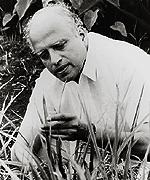The Most Influential Asians of the Century
A cavalcade of towering individuals and a newly awakened populace
Emperor Hirohito - Diffident dynast
Ho Chi Minh - Uncle Insurgent
Pol Pot - Heart of Darkness
Issey Miyake - Beautymaker
Daisuke Inoue - Karaoke King
Rabindranath Tagore - People's Poet
Sun Yat-sen - Father to All China
Mohandas Gandhi - Peacefull Warrior
Sukarno - Revolution's Star
Mao Zedong - Red Emperor
Lee Kuan Yew - Master Planner
Deng Xiaoping - Strategist Supreme
Corazon Aquino - Lady Liberty
Park Chung Hee - Task Master
Eiji Toyoda - Auto Motivator
King Rama V - Royal Reformer
M S Swaminathan - Green Revolutionary
Akira Kurosawa - Ace Auteur
Dalai Lama - Apostle of Peace
Akio Morita - Gadget Man
|
|
Born Aug. 7, 1925 in India
1952 Graduates from Cambridge with a Ph.D in genetics
1966 Uses Mexican seeds in Punjab, which results in vastly increased harvests
1967 His team develops high-yield, cross-bred wheat seed that starts Green Revolution across S E Asia
1971 Awarded the Ramon Magsaysay Award for Community Leadership
1974 Chairs U.N. World Food Congress in Rome
1987 Wins the World Food Prize in Washington
The father of the Green Revolution used his skills in genetic engineering and his powers of persuasion to make famine an unfamiliar word in Asia
If you travel by land from any Asian metropolis, it doesn't take long to hit a timeless landscape carpeted with fields of rice, wheat, millet or maize. Whether you're at the rice paddies of Kuttanad, Kerala in southern India or the wheat bowl of central China, farmers tend fields as their ancestors did, harvesting grain for their families and countrymen.
But beneath the soil of those seemingly unaltered tableaux is a high-tech invention that changed not only Asia but the world. The seeds planted today by farmers from Punjab to Pusan are nothing like those used by their ancestors. If they were, the entire continent would either be starving or enslaved to the outside world for food or financing.
That turn of history, one of the truly astonishing transformations of the century, is now known as the Green Revolution. It relied heavily on the work of a diminutive Indian geneticist named Monkombu Sambasivan Swaminathan. As godfather of the Green Revolution, Swaminathan, 74, is modest about his own achievements but forthright about his work's impact on his native land and the planet Earth. "Our history," he says, "changed from that time."
Swaminathan, together with colleagues in India and around the world, managed in a few short years to demolish the dire Malthusian worldview that was so prevalent, and pertinent, four decades ago. Asia's populations were growing uncontrollably. None of the largest countries was self-sufficient in food. China lost as many as 30 million people to famine from 1958 to '62 during and after the Great Leap Forward, and postwar India lived a "ship-to-mouth" existence, subsisting on foodgrains imported from the U.S. Too many mouths, ever more pregnancies, the same farmers growing the same crops--something had to give.
Instead of tragedy, though, a miracle was born in the mid-'60s at Swaminathan's laboratory in New Delhi--and, a few years later, at the International Rice Research Institute in the Philippines which he later headed. Swaminathan brought into India seeds developed in Mexico by U.S. agricultural guru Norman Borlaug and, after cross-breeding them with local species, created a wheat plant that yielded much more grain than traditional types. Scientists at IRRI accomplished the same miracle for rice. Imminent tragedy turned to a new era of hope for Asia, paving the way for the Asian economic miracle of the 1980s and '90s.
As with all great revolutions, though, the seed was but the starting point. Swaminathan combined all the great components of a revolutionary: vision, dedication, energy and follow-through. He was born in what is now the southern Indian state of Tamil Nadu. His physician father was an ardent follower of Mohandas Gandhi, and the young Swaminathan was brought to a rally in which British cloth was burned. (Gandhi exhorted Indians to end their dependence on imported goods.) It was a lesson the boy would never forget. In college, he eschewed more lucrative professions and studied agriculture. "I believed I had to serve the nation," he says from his Madras-based M.S. Swaminathan Research Foundation, which is involved in a range of activities, including ways to hook farmers up to the Internet. He almost became a police officer, but a 1949 fellowship to study genetics in the Netherlands changed his career path. In 1952 he earned his Ph.D from Cambridge University, then crossed the Atlantic on the liner Queen Elizabeth to do further studies in Wisconsin. There he turned down a professorship. "I asked myself, why did I study genetics? It was to produce enough food in India. So I came back."
Swaminathan's poor, overpopulated homeland was importing vast amounts of grain. "Importing food was like importing unemployment," he recalls. "Seventy percent of our people were employed in agriculture. We were supporting farmers in other countries." By 1966, Swaminathan was director of the Indian Agricultural Research Institute in New Delhi, spending his time in fields with farmers trying to help improve their productivity. Fertilizers were a dead end: when the wheat plant's pod grew more seeds, its stalk collapsed under the weight. With help from the Rockefeller Foundation, Swaminathan found a cross-bred wheat seed, part-Japanese and part-Mexican, that was both fruitful and staunch. (He would later marry this plant to an Indian variety to produce the golden-colored grain favored by Indians.)
That was the breakthrough in the Green Revolution, but there was a lot more work to be done. Indian farmers, immersed in traditional ways, had to be convinced to grow the new wheat. In 1966, Swaminathan set up 2,000 model farms in villages outside New Delhi to show farmers what his seed could do. Then came the hardest part. He needed the government to help--specifically, to import 18,000 tons of the Mexican seed at a time of fiscal hardship. Swaminathan lobbied then-Prime Minister Lal Bahadur Shastri. "He probably thought nothing could be worse," Swaminathan recalls. "Famine was imminent. There was a willingness to take risks." The first harvest with the new seeds was three times greater than the previous year's.
But the revolution was still incomplete. Only Punjab state had the right irrigation for the new technologies, the state-run food collection and distribution networks were notoriously inefficient, and new fertilizers and pesticides were needed, along with credit lines for small farmers. Political leadership was vital to solve that tangle of problems, and Swaminathan found it in Shastri's successor. "Indira Gandhi was a strong nationalist," he recalls. "She wanted an independent foreign policy, and food was a political weapon." Gandhi bluntly asked him how India could be free of imports and gave Swaminathan a free hand to organize a new agricultural program. Today, India grows some 70 million tons of wheat a year, compared to 12 million tons in the early '60s.
Swaminathan now believes farmers must adopt more eco-friendly methods, and he's using his influence to spread the message. And although populations continue to mushroom, he maintains that still greater harvests are possible. All that's needed, he says, is "inspiration, perspiration and luck." The greatest stroke of luck for hundreds of millions of Asians has been Swaminathan's revolution.
Reported by Meenakshi Ganguly/Madras
|


